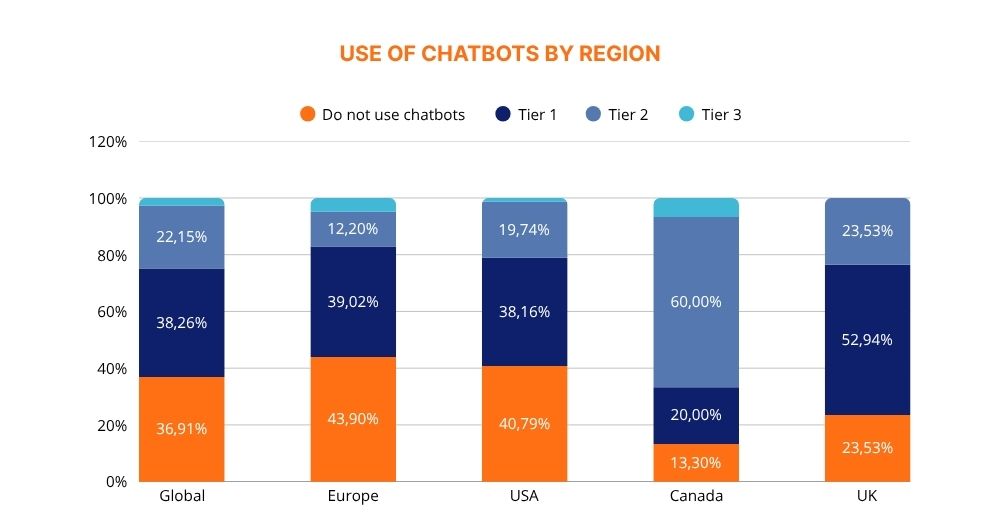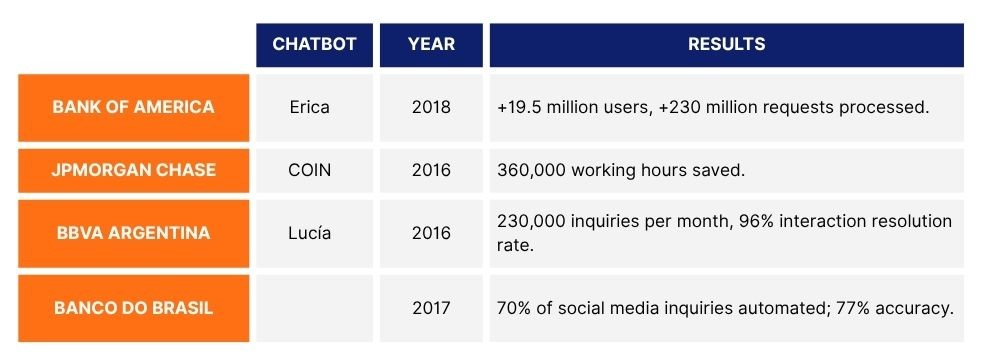
In a world where immediacy and personalization are no longer differentiators but baseline expectations, financial institutions face a pressing challenge: rethinking how they engage with their customers.
This is where conversational banking comes into play—a strategy that has been steadily gaining ground in the financial sector and is now delivering tangible results.
But how widely has it been adopted? And is conversational banking truly ready to meet today’s customer expectations?
In this article, we explore real use cases, current adoption levels, representative implementation examples, and a breakdown of the key benefits and limitations of conversational banking.
What is conversational banking?
Conversational banking is a digital interaction model that allows customers to communicate with their bank through chatbots, virtual assistants, and instant messaging—making it easier to handle inquiries and banking operations without the need for direct human interaction. Its goal is to enhance the user experience by providing fast, personalized responses anytime, from any device.
Unlike traditional self-service channels, conversational banking leverages artificial intelligence (AI) and natural language processing (NLP) to understand customer intent and deliver real-time, contextualized solutions. This not only speeds up service but also enables more natural and effective interactions.
Banks have integrated conversational banking across multiple channels to create a smoother and more accessible experience:
- Mobile apps: In-app chatbots that handle queries and transactions.
- Websites: Virtual assistants that guide users and offer real-time support.
- Instant messaging platforms: Integration with WhatsApp, Facebook Messenger, and other channels to interact with customers.
- Voice assistants: Compatibility with devices like Amazon Alexa or Google Assistant to manage queries via voice commands.
Effective use cases of conversational banking
The implementation of conversational solutions in the financial sector has led to a variety of approaches aimed at strengthening the relationship between banks and their customers. These strategies—often built around digital channels like WhatsApp—are being assessed for their ability to streamline processes, lower operational costs, and deliver a more personal and efficient experience.
Below, we highlight several use cases where this approach has already been put into practice with meaningful results for the industry.
Simplifies the acquisition of new products and services
People no longer want to fill out forms or wait in line at a branch to get a financial product. According to Meta, over 75% of Latin American consumers now prefer to engage with brands through messaging channels like WhatsApp. And it’s not just a preference—conversational campaigns promoting credit cards, loans, or insurance via WhatsApp are showing conversion rates up to 30% higher than traditional channels. These results stem from removing friction and leveraging the user’s moment of interest.
This not only speeds up the acquisition of new products. It also lowers CAC (Customer Acquisition Cost) and enables more precise segmentation based on user behavior within the channel itself.
Automated and/or personal customer service via chat
Post-sale contact can no longer mean waiting in a phone queue or sending an email that never gets answered. Conversational customer service allows support to be provided, requests to be resolved, and services to be modified in an automated, efficient, and human way. From activating or blocking cards to updating information or receiving security notifications—everything happens within a conversation.
This has enabled banks and insurance companies to reduce call center volume by up to 40%, while improving NPS (Net Promoter Score) thanks to an intuitive, 24/7 self-service experience. Additionally, with full traceability of interactions, there are new opportunities to optimize processes and detect customer insights in real time.
Effectiveness in enabling frictionless payments
Talking about collections no longer has to create friction with the customer. In fact, debt recovery campaigns through WhatsApp are proving to be 20% more effective than traditional methods, as they allow for negotiation, payment commitments, and resolving questions through a familiar, pressure-free channel.
This not only improves recovery rates. It also reduces operational costs for the collections department and helps preserve the customer relationship by keeping the communication tone within a positive experience—even in sensitive situations.
Auronix and Latinia: Specialized partners in conversational banking
Partnering with specialized technology providers is key to ensuring an effective and sustainable implementation over time. In this regard, Auronix has become one of the main allies driving conversational transformation in the financial sector.
Auronix is a leading conversational solutions company in Mexico, known for its ability to automate critical business processes, enhance customer experience, and reduce operational costs. These strengths have made it a trusted technology provider for many financial institutions.
Additionally, Auronix is an official Meta Solution Partner, which enables it to offer direct integration with the WhatsApp Business Platform, manage business accounts, provide guidance on best practices, and deliver expert support. This accreditation strengthens its position as a leader in conversational channels and ensures that implementations meet the highest standards in both technology and user experience.
Auronix is a certified partner in Latinia’s Partner Program, an initiative designed to help banks identify and select top-tier technology providers.
Our goal is to be a trusted guide in this process. We thoroughly evaluate each partner before integrating them into the network, ensuring they meet the highest standards in quality, specialization, and alignment with the needs of the financial sector.
In doing so, we simplify technology decision-making and give banks access to validated, reliable solutions that accelerate innovation and enhance competitiveness.
Technologies, adoption levels, and current data on conversational banking
Conversational banking has evolved rapidly, driven by advances in artificial intelligence, pressure to reduce operational costs, and changing user habits. Even so, implementation has not been consistent across all regions.
According to The Financial Brand, existing chatbots can be grouped into three levels of sophistication:
- Tier 1: Basic tools, similar to an interactive search engine. They can answer simple questions, but their main function is to redirect users to articles or help sections.
- Tier 2: In addition to the above, they provide extra information and contextualized links related to the query.
- Tier 3: The most advanced. Based on artificial intelligence, they can process natural language, understand complex questions, and solve them directly within the conversational channel.
The Financial Brand study highlights that 63.1% of the institutions analyzed have some type of chatbot. However, most fall into the lower tiers of functionality:

From a geographic perspective, adoption levels vary significantly:
- In the European Union, 43.9% of institutions do not have a chatbot. Those that do are mostly in Tier 1 or Tier 2.
- In the United States, 40.8% of banks also lack a chatbot. Only one—Bank of America—has a Tier 3 chatbot.
- Canada stands out with the highest percentage of mid-tier (Tier 2) chatbots.
- The United Kingdom is the only country in the study with no examples of advanced chatbots (Tier 3).
These findings show that, despite technological progress, conversational banking has yet to reach widespread maturity.
The rise of conversational banking in Latin America
Conversational banking has also begun to gain ground in Latin America, although its level of adoption remains lower than in Europe or North America. The region’s technological priorities are increasingly focused on automated customer service solutions, and the use of artificial intelligence to enable conversational channels is already among the top investment areas.
According to the Pulso 2024 Report, over 60% of banks and microfinance institutions in the region plan to implement AI-based chatbots to improve digital service. In countries like Peru, conversational banking ranks as the third-highest technology priority for the next two years.
Although the level of maturity is lower than in the U.S. or Canada, the expansion of mobile internet, the digitalization of financial services, and pressure from fintechs are accelerating adoption. At the same time, satisfaction with digital channels is high—84% among banking customers, according to the same report—which encourages the use of new forms of interaction, including virtual assistants.
Some standout examples include:
- BBVA Mexico (2015): Launched a virtual assistant powered by artificial intelligence and integrated with WhatsApp. It allows users to make inquiries via text or voice about products, branch locations, and digital features, with machine learning capabilities that improve interaction over time.
- Banco do Brasil (2017): Introduced a cognitive AI chatbot for customer service via social media, initially on Messenger. After a pilot phase with employees, the solution was opened to the public and gradually expanded to handle topics such as cards, accounts, credit, and loyalty programs. Unlike other bots in the Brazilian market, it offered a fully conversational experience, using buttons only for specific functions.
- Bancolombia (2018): Implemented Tabot, a chatbot with natural language processing (NLP) available on Facebook Messenger. The assistant can respond to questions about balances, transactions, ATM locations, or credit processes, and is available 24/7.
- BCP (Peru, 2024): Launched Clara, a phone-based virtual assistant powered by NLP. It handles requests such as transaction inquiries, online purchase activation, or payment installment plans. The system adapts to users’ language and escalates more complex cases to human agents.
Results of conversational banking implementation
According to a study by Juniper Research, the banking sector has saved over $7.3 billion through the use of chatbots. In addition, Autonomous Research estimates that banks could save up to $1 trillion by 2030 through automation powered by these tools.
Below, we review some of the results reported by specific banks after implementing conversational banking solutions:

Benefits and limitations of conversational banking
Below, we highlight the main benefits that conversational banking offers, along with the limitations that still remain in its development.
Key benefits
- Instant support and 24/7 availability: Allows customers to get answers and manage tasks at any time.
- Interaction through familiar channels: Communicating with the bank via WhatsApp or Facebook Messenger makes adoption easier and improves the user experience.
- Personalized experience: AI-powered systems can tailor responses and recommendations based on each user’s behavior, history, or financial profile.
- Reduced operational costs: According to Juniper Research, banks have already saved over $7.3 billion through chatbots, and Autonomous Research projects savings of up to $1 trillion by 2030.
- Stronger customer loyalty and engagement: By offering smooth, contextual service, banks strengthen customer relationships and reduce churn.
- Real-time data analysis: Every conversation generates valuable data to personalize services, identify business opportunities, and support informed decision-making.
Current limitations
Despite its potential, conversational banking still faces important challenges:
- Limited system sophistication: Only 2.7% of banks have Tier 3 chatbots—the most advanced level. Most remain at the most basic functional levels.
- Lack of trust in automated financial advice: According to J.D. Power, while 72% of customers believe AI will improve banking self-service, only 42% think it will help improve their personal finances.
- Need for transparency and oversight: As noted by the American Bankers Association, the deployment of conversational agents must comply with regulatory standards, ensure ethical automated decisions, and always provide the option to escalate to a human agent.
Technologies that enable conversational banking
Conversational banking is much more than a chatbot answering questions. The key lies in the combination of technologies that enable smooth, secure, and personalized interactions. Thanks to these advances, banks can optimize communication with their customers, enhance the user experience, and reduce operational costs.
The main technologies that make conversational banking possible include:
- Artificial Intelligence (AI) and Natural Language Processing (NLP): Allow virtual assistants to understand the context of conversations, interpreting user intent beyond basic text commands.
- Machine Learning and transactional data analysis: Analyze customer behavior to personalize interactions, offering tailored recommendations and solutions.
- Integration with banking APIs: Enables chatbots to connect with the bank’s internal systems, allowing customers to carry out transactions and inquiries without leaving the conversational channel.
Conversational banking: An increasingly common approach in the financial sector
The reality is clear: customers are already using these channels. That’s why more and more banks are adopting this strategy to achieve real business results. Institutions that have embraced conversational banking aim to improve efficiency, reduce costs, and build stronger, more sustainable relationships with their customers.
In an increasingly competitive and digital market, investing in conversational banking is more than a tech decision—it’s a business strategy.
To move forward successfully, it’s essential to work with technology providers who not only offer innovative solutions, but also understand the specific challenges of the financial sector. However, selecting the right service provider can be a complex and demanding process.
Looking for a conversational banking partner?
At Latinia, we help you identify the solutions that best fit your conversational strategy. If you’re looking for a specialized and trusted provider, contact us to learn more about Auronix and our Partner Program.
Categories: Cloud & Tech, Customer Experience
